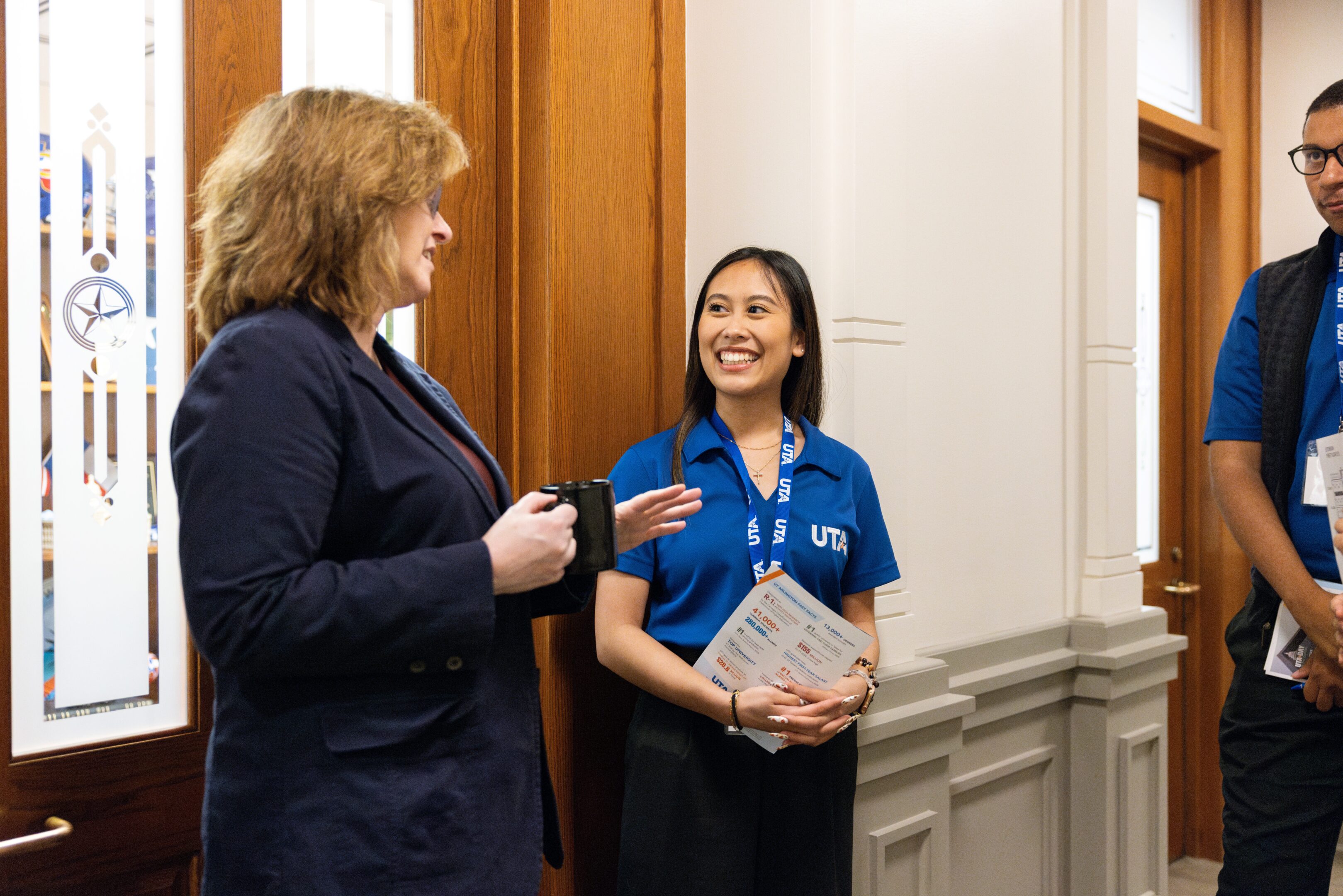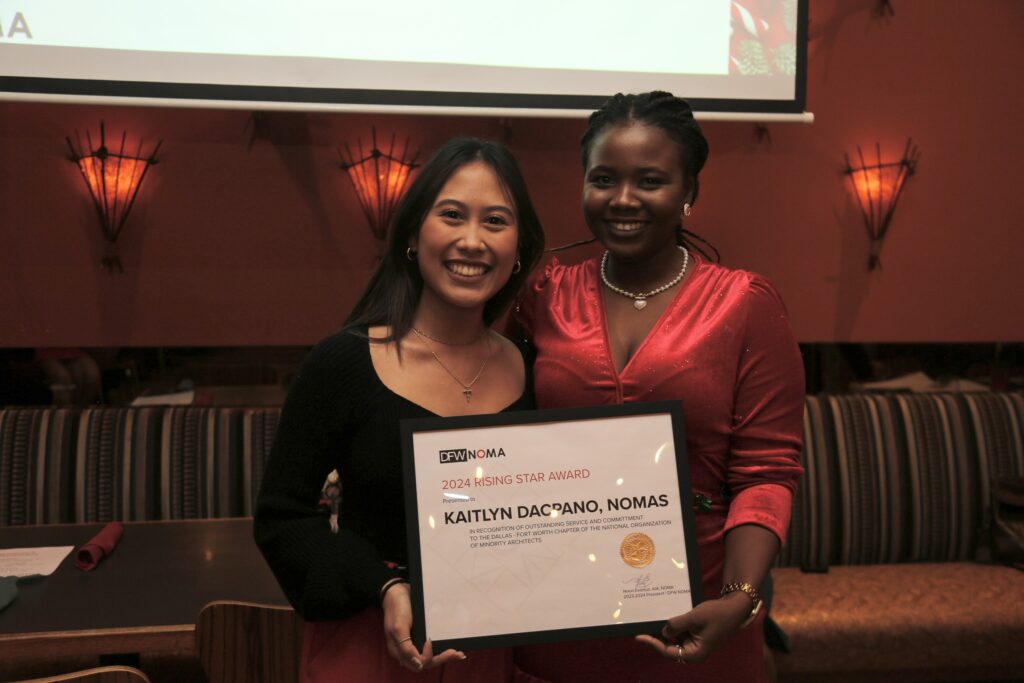Building More Than Structures
 Kaitlyn Dacpano at UTA Day at the Capitol
Kaitlyn Dacpano at UTA Day at the Capitol
When Kaitlyn Dacpano began her college journey in the middle of a global pandemic, the future felt uncertain. Like many first-generation college students from immigrant families, she faced the weight of expectation—pressured to follow a stable path in education or healthcare, like her parents and older sister. But one high school course changed everything. After enrolling in an architecture class at the Gilbreath-Reed Career and Technical Center in Garland ISD her senior year, she discovered a deeper calling: to impact lives through the built environment.
A class project designing a revitalized green space for a local elementary school proved to be a pivotal moment. “Seeing the kids’ excitement when they saw my design—it just clicked. I realized architecture could change lives just like medicine or education, by shaping spaces that promote well-being and community.”
Now a graduate student in UT Arlington’s College of Architecture, Planning, and Public Affairs, Kaitlyn stands at the forefront of student leadership, serving as President of the National Organization of Minority Architecture Students (NOMAS) at UTA. Her involvement in student organizations has not only enriched her college experience but is actively shaping the architect she’s becoming.
Finding Her Place Through NOMAS
Her journey with NOMAS began in her third year of undergraduate. “At first, I joined just because a close friend on the executive board encouraged me. I had no idea what the organization was really about.” But that simple act of trust led to an experience that would transform her time at UTA. NOMAS, the student branch of the National Organization of Minority Architects (NOMA), quickly became a cornerstone of her academic and personal growth.

She rose through the ranks—first as Event Coordinator, then Vice President, and eventually President. In each role, she expanded outreach, mentored younger students, and built strong relationships across campus and the profession. Under her leadership, the chapter thrived and was recognized within the broader design community. In 2024, she was honored with the DFW NOMA Rising Star Award, a recognition of her impact and dedication.
Beyond NOMAS, she also became involved with CAMP, a UTA-specific mentorship initiative under AIAS that connects students across degree levels and with practicing professionals. “CAMP gave me a more personal experience. I’m a huge believer in mentorship—sharing knowledge between students and professionals strengthens our entire field.”
Beyond the Studio: Growth Through Leadership
While architecture school is notoriously rigorous, student organizations offered her both an outlet and a support system. “NOMAS helped me enjoy the process of earning my degree. It gave me community, perspective, and moments of reprieve from studio stress.” Weekly meetings, events, and even small social gatherings became essential to her well-being—and helped her remember that she wasn’t navigating the pressure of studio culture alone.
But these experiences offered more than balance. Through leadership, she developed skills often overlooked in the classroom: public speaking, organizational management, time coordination, and conflict resolution. “I became more confident in reviews, more effective in communication, and better prepared to lead project teams.”
Her ability to collaborate also evolved. “Serving on executive boards taught me how to work with different personalities and delegate tasks—skills that directly translated into stronger team dynamics during group studio projects.”

From Campus to Career
Her leadership didn’t go unnoticed. In 2024, Kaitlyn became the first UT Arlington student selected as a NOMA Future Faces Fellow—a distinction that opened professional doors, including an extended internship at the architecture firm Page, where she continues to work part time today.
NOMAS also connected her to national networks of students and professionals. “Whether it was designing an exhibit for the 2023 TxA Conference, attending the Texas Technology Student Association Annual Conference, or participating in UTA Day at the Texas Capitol, these experiences would not have happened without NOMAS.”
Kaitlyn also pays it forward—offering guidance to NOMAS students at other Texas universities like UH and PVAMU, sharing strategies to build stronger chapters and deepen their ties with local professional NOMA organizations.
One initiative she holds close is NOMA Project Pipeline, a summer architecture camp for middle and high school students. “Watching young students light up as they learn about design reminded me why I chose this profession in the first place—outreach matters.”
Looking Ahead—and Giving Back
Although still in graduate school, she’s already witnessing how her leadership journey gives her an edge in the professional world. “Managing NOMAS taught me how to organize work, support others, and advocate for myself. These are the same skills I use at my internship every day.”
She plans to remain actively involved with DFW NOMA and to mentor students through NOMAS and CAMP even after graduation. “These communities helped shape me, and I want to do the same for others coming up behind me.”


Advice for Future Students
Her message to current and future architecture students is clear: get involved. “Student organizations are one of the most valuable parts of the college experience. The opportunities for leadership, connection, and growth are life changing. I wouldn’t be where I am today without NOMAS.”
If there’s one thing she would do differently? “I took on too much during my time as President. I wish I had trusted my board more and delegated better. Leadership is about collaboration, not carrying it all yourself.”
And for universities and faculty: “Architecture programs can do more to encourage involvement. Only a few of my professors emphasized the value of student leadership. Stronger institutional support could make a huge difference.”
Kaitlyn Dacpano’s story is a testament to how architecture is not only about designing buildings—but about building people, communities, and futures. Through NOMAS and mentorship, she’s not just learning to design a better world—she’s already helping create it.